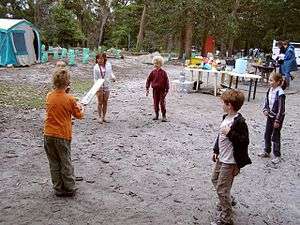French cricket

French cricket is an informal game derived from the sport of cricket. There is only one batsman, and their objective is to not be dismissed by the other participants - who are fielders, or a bowler if they have possession of the ball - for as long as possible. The objective of the other participants is to dismiss the batsman. There are only two methods of dismissal, being caught or being "leg before wicket", but as there are no stumps, this method of dismissal is effected by a bowled ball hitting the batsman's legs typically below the knees. Once the batsman is dismissed, the other participant who took the catch or effected the "lbw" typically replaces them as batsman, and the game-play begins again. There are many varieties of additional rules. The batsman may be obliged to stay with their legs in the same place, facing the same way for the whole of their innings; they may remain in the same place but be permitted to change their stance if they effect a shot by hitting the ball; or, they may be able to freely move around after playing a shot. The batsman may also score runs in some variations of the game.
Basic rules
The batsman stands stationary with the bat protecting their legs, their legs being the "stumps" of formal cricket.[1] Whichever other player has the ball throws it at the batsman attempting to dismiss them by hitting their legs. If the batsman hits the ball, the other participants may also dismiss the batman by a catch.[2][3]
Playing French cricket
French cricket is most commonly played by children, or mixed groups of children and adults, although adults sometimes play it as a diversion during outdoor parties or on picnics.[2] If the game is played more seriously, players take turns to bat and the player who batted for the most balls or the longest time is considered the winner.
Equipment
The ball is typically a tennis ball, bowled underarm at the legs of another player holding a cricket bat, a tennis racquet, or some other object that can be used as like a cricket bat.
Batting
The player holding the bat, the batsman, is required to block and defend his "wicket", with the batsman's legs taking the place of the stumps. The batsman is not allowed to move their legs, and in some variants, the batsman can only hit the ball in a direct upward or scooping-like motion.
Fielding
Any number of fielders can stand around the batsman, and any fielder can bowl at the batsman from any angle.
Rule varieties
Batting
- Often, the batsman is only allowed to turn to face the next delivery if they hit the ball. If they miss and are not dismissed, they must attempt to play the next ball (which is bowled from where the ball ended up after the previous delivery) without being allowed to turn to face it. Sometimes additionally, if the batsman does not turn to face the ball before a fielder picks it up, they would have to turn their waist and face the fielder bowling in order to hit the ball.
- In some variations, the batsman is not allowed to turn at all, and is declared out if their feet move. Restrictive rules like this also help to contain the ball in smaller areas such as backyards.
- In other variations, if the batsman has effected a shot, they can relocate as fast as they can run, until a fielder has the ball in their hands.
- In other variations, a batsman can score runs. Alternatively, when the batsman hits the ball, he can make 'runs' by revolving the bat around themselves with both hands. A batsman can take these runs until the ball is in the hands of a fielder and they call 'ready'.
Fielding
- In one variation, once the fielder has fielded the ball they cannot take any steps until they have bowled the ball or passed the ball to another fielder. Passes to fielders can be thrown overarm or sidearm but to get a batter out with a direct throw the fielder must throw the ball underarm.
- Sometimes the batsman can be caught out "one-hand one-bounce". When this rule is applied, the batsman will also be dismissed if the catcher takes the ball with one hand after it has bounced only once on the ground.
Origin of the name
Suggested possibilities include juxtaposition with the English origin of regular cricket.[2] It seems likely that as the game is a lesser version on regular cricket that the name is intended to mock both the game and the French — just as a "French cut" in the sport of cricket is a poorly executed cut shot which almost gets a batsman out. The name may also have arisen from the similarity of the batting motion to the one used in croquet which while not a French game is sometimes assumed to be French because of its name.
See also
In popular culture
- In Series Two of The Office some male staff members are shown playing French cricket with their boss Neil Godwin.
References
- ↑ "KidsSport_Frenchcricket" (PDF). Department of Sports and Recreation of New South Wales. Retrieved 2009-10-19.
- 1 2 3 Fennell, Tim (2009-08-13). "Sort of sport - French cricket". The Daily Telegraph. Retrieved 2009-10-18.
- ↑ "HITTING WITH A CRICKET BAT ACTIVITY 271 FRENCH CRICKET" (PDF). Australian Sports Commission. Retrieved 2009-10-19.